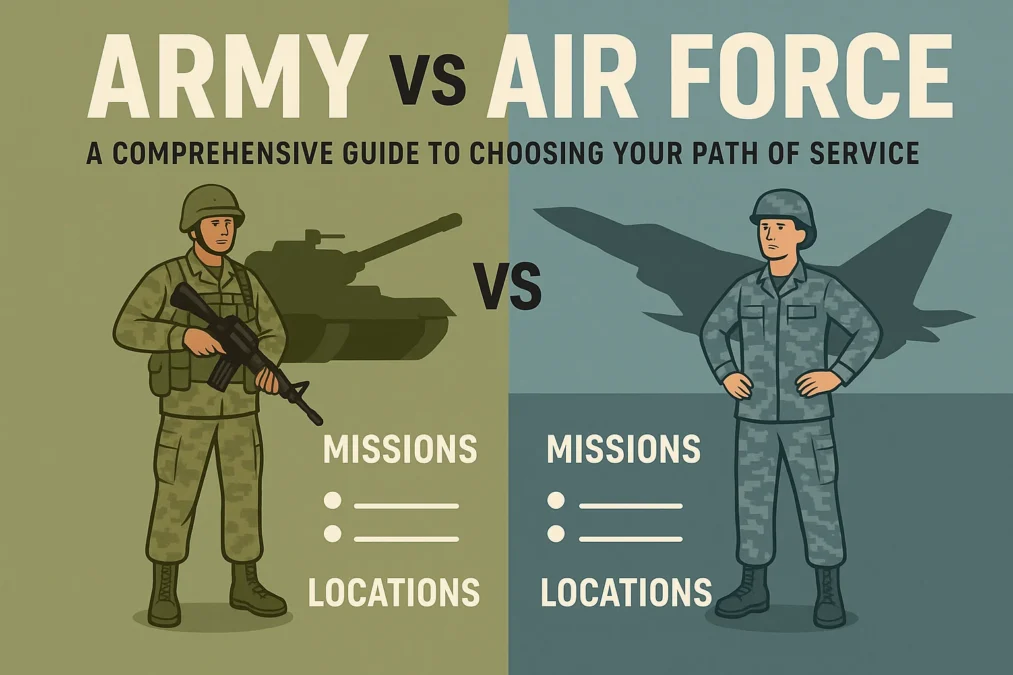Embarking on a career in the United States military is one of the most significant decisions a person can make. It’s a commitment to service, personal growth, and challenging work. But before you even step into a recruiter’s office, a fundamental question arises: which branch is right for you? For many, the choice boils down to a classic comparison: the Army vs Air Force. These two giants of the U.S. Armed Forces offer incredible opportunities but embody distinctly different cultures, missions, and ways of life. This isn’t just about choosing a job; it’s about choosing an identity and a lifestyle for the next several years.
This definitive guide is designed to dissect every aspect of the Army and Air Force comparison. We’ll move beyond the stereotypes and delve into the tangible differences in their core missions, training, career fields, day-to-day life, and overall culture. Whether you’re drawn to the structured, ground-poundin’ legacy of the Army or the technical, amenity-focused world of the Air Force, understanding these nuances is critical. Our goal is to provide you with the clarity needed to make an informed decision, ensuring you find the branch that best aligns with your personal goals, professional aspirations, and personality. This journey is about finding where you belong in the proud tradition of American military service.
The Core Mission and Philosophical Divide
At the heart of the Army vs Air Force discussion is a fundamental difference in purpose. Their missions dictate their structure, their strategy, and ultimately, the experience of every single service member.
The United States Army’s mantra is “This We’ll Defend.” As the oldest and largest branch of the U.S. military, its primary mission is to conduct sustained land combat operations. The Army is the force that seizes, occupies, and defends territory. It’s built on the principle of boots on the ground, with soldiers engaging directly with adversaries and civilian populations. The Army’s philosophy is one of resilience, adaptability, and sheer force. It operates across the full spectrum of conflict, from large-scale ground wars to peacekeeping missions and humanitarian aid. A soldier is trained first and foremost as a warrior, regardless of their specific job (Military Occupational Specialty or MOS). This foundational identity means that even a finance clerk or a band member in the Army is a rifleman first, trained to defend themselves and their position.
The United States Air Force, by contrast, was established with a different domain in mind: air, space, and cyberspace. Its core mission is to fly, fight, and win in the air, space, and cyberspace domains. The Air Force’s philosophy is heavily centered on technological superiority, precision, and strategic impact. The idea is to achieve objectives and dominate adversaries from a distance, using advanced aircraft, satellite technology, and cyber capabilities to control the battlespace. While every Airman is a defender of their nation, their primary identity is often tied to their technical expertise. The focus is on mastering complex systems to deliver effects—whether it’s through air superiority, global strike, rapid global mobility, or intelligence, surveillance, and reconnaissance (ISR). This creates a culture that highly values education, certification, and specialized skill sets.
Culture and Lifestyle: A World of Difference
The divergent missions of these branches naturally cultivate vastly different cultures and day-to-day lifestyles for their members. This is often the most decisive factor for individuals choosing between the Army and Air Force.
Army culture is steeped in tradition, discipline, and a rugged, team-oriented ethos. The phrase “Embrace the Suck” encapsulates a lot of the Army mindset—it’s about persevering through difficult, uncomfortable, and demanding conditions together. Life in the Army often involves more time in the field, longer training exercises, and a greater acceptance of austere living conditions. The hierarchy is pronounced, with a clear chain of command and an emphasis on rank and customs. Physical fitness is a paramount and constant focus, with the Army Combat Fitness Test (ACFT) demanding a high level of raw strength and endurance. The culture fosters intense camaraderie; going through shared hardship forges powerful bonds between soldiers. You live, train, and overcome challenges as a unit.
Air Force culture, frequently summarized by the unofficial motto “Aim High,” tends to prioritize a more corporate and technical environment. It’s often described as the most “business-like” of the military branches. The focus is on efficiency, innovation, and the smooth operation of high-value assets. Because their “workspace” is often a hangar, a control tower, or an office building, the day-to-day life for many Airmen can feel more structured and predictable, resembling a 9-to-5 job compared to the Army’s field rotations. This extends to base amenities as well, which are famously better; Air Force bases consistently rank highly for their facilities, housing, and recreational options. The physical fitness standard, the Air Force Physical Fitness Test (PFT), emphasizes cardiovascular health and body composition over the raw strength tests of the Army, reflecting the different physical demands of the respective jobs.
Basic Training and Initial Entry
Your first introduction to military life is Basic Military Training (BMT), and the experience differs significantly between the two branches, setting the tone for your entire career.
Army Basic Combat Training (BCT) is a grueling 10-week course designed to break down the civilian and build up a soldier. It is physically and mentally demanding, with a heavy emphasis on land navigation, weapons proficiency, tactical movements, and surviving in field conditions. Recruits spend a considerable amount of time in the “field,” sleeping in makeshift shelters, conducting patrols, and undergoing simulated combat exercises like the infamous gas chamber and night infiltration course. Drill Sergeants are tasked with instilling discipline, resilience, and a warrior ethos through intense, in-your-face instruction. The entire process is designed to stress the individual to their limits to teach them how to operate effectively as part of a team under extreme pressure. It’s a transformative experience that forges a common identity among all soldiers, regardless of their future job.
Air Force Basic Military Training is an 7.5-week program held at Joint Base San Antonio-Lackland in Texas. While it is undoubtedly challenging and designed to transition civilians into Airmen, its approach and focus areas are different. There is a significant focus on discipline, Air Force core values, and military bearing, but the physical and fieldcraft demands are less intense than in the Army. Training includes familiarization with weapons (though to a lesser proficiency standard) and a field exercise that introduces basic combat skills, but the overarching goal is different. Much of the training revolves around preparing Airmen for the technical and academic rigors of their next phase: Technical Training. The Military Training Instructors (MTIs) are strict and demanding, but the culture is less about “breaking you down” and more about building you into a professional who can handle the Air Force’s technologically advanced mission set.
Career Opportunities and Job Specialties
Both the Army and Air Force offer a stunning array of career fields, from combat arms to cyber warfare to medical services. However, the distribution, focus, and training for these jobs highlight the branches’ different priorities.
The Army boasts the largest number of diverse career paths, with over 150 different Military Occupational Specialties (MOSs). These are broadly categorized into branches like Infantry, Armor, Artillery (the combat arms roles), as well as Cyber, Signal, Intelligence, Medical, Logistics, and many more. A key feature of the Army is its “needs of the Army” policy, which means your job assignment and duty station are ultimately determined by the branch’s requirements, though your preferences are considered. Training for a specific MOS can vary from a few weeks for some support roles to over a year for highly technical fields. A significant advantage for the Army is its size, which can sometimes mean more opportunities for promotions in certain fields and a greater number of duty stations, including many remote or overseas locations that offer unique cultural experiences.
The Air Force organizes its careers into Air Force Specialty Codes (AFSCs). While the total number of specific jobs is fewer, a much larger proportion of these jobs are highly technical in nature. The Air Force is the branch for those interested in directly working with advanced aircraft, space systems, network infrastructure, and cyber security. Even many support roles require specialized technical training. The Air Force places a heavy emphasis on formal education and professional certifications, often tying them directly to promotion. The assignment process, while still based on the needs of the service, often allows for more input and a “dream sheet” system. The perception, often backed by data, is that the skills learned in the Air Force can have a very direct and valuable translation to the civilian sector, particularly in aviation, IT, and engineering fields.
Quality of Life and Base Amenities
The day-to-day living conditions for service members and their families can be a major tipping point in the army vs air force debate. This is where the branches’ different funding priorities and cultures become most apparent.
Life on an Army post is functional and can be excellent, but it often lacks the consistent level of investment seen on the Air Force side. Housing quality can vary dramatically from one post to another, with some being modernized and others feeling quite dated. The same goes for facilities like gyms, community centers, and recreation areas. Army life is more accepting of “roughing it,” and soldiers can expect to spend more time living in tents or austere barracks during field training exercises. Deployments for Army units are often longer and to more rugged forward operating bases. The Army family support structure is robust out of necessity, given the frequent moves and deployments, but the overall quality of life is often seen as more challenging and less predictable than in the sister services.
The Air Force has consistently invested in what it calls “Quality of Life” for its Airmen, and it shows. Air Force bases are routinely ranked as the best places to be stationed across the military. They typically feature newer housing, state-of-the-art fitness centers, better shopping exchanges (BX), and more recreational facilities like pools, golf courses, and bowling alleys. The “barracks” for single Airmen are often modern dormitories with private rooms and shared common areas. This focus on comfort and amenities is not frivolous; the Air Force rationale is that a well-rested, comfortable, and content Airman is better able to focus on the complex and high-stakes tasks of operating multi-million dollar aircraft and global satellite systems. For many, this elevated standard of living is a primary reason for choosing the Air Force over the Army.
Physical Fitness and Standards
Physical readiness is a non-negotiable requirement in any military branch, but the tests and standards reflect the unique physical demands placed on soldiers and Airmen.
The Army’s fitness test is the Army Combat Fitness Test (ACFT), a six-event assessment designed to better simulate the physical demands of combat. It consists of a Deadlift, Standing Power Throw, Hand-Release Push-Ups, a Sprint-Drag-Carry, Plank, and a two-mile run. The ACFT is graded on a scale with different minimum standards for different military occupational specialties, acknowledging that a cook and an infantryman have different physical jobs. However, the overall test is grueling and requires a blend of raw strength, power, endurance, and stamina. It embodies the Army’s warrior ethos and the expectation that every soldier, regardless of job, must be physically prepared to handle the rigors of a combat environment.
The Air Force employs the Air Force Physical Fitness Test (PFT). This test consists of four components: aerobic fitness (typically a 1.5-mile run), body composition (measured by abdominal circumference), push-ups, and sit-ups. The scoring is age and gender-normed. The clear difference is the absence of strength-based events. The Air Force test prioritizes cardiovascular health, core endurance, and maintaining a healthy weight. This aligns with the reality that many Air Force jobs are highly technical and require long hours of mental focus, often in a fixed position. While Airmen in security forces or special warfare roles have separate, more demanding standards, the regular PFT reflects the branch’s overall focus on a different kind of readiness.
Education and Career Advancement
Both branches offer tremendous opportunities for education and professional advancement, but their systems and cultures surrounding promotion can feel different.
Advancement in the Army is a structured process based on a point system. Points are accrued for things like time in service, time in grade, military education, civilian education, awards, and performance evaluations. Promotions up to a certain rank (typically Sergeant E-5) can be relatively rapid, especially in high-demand fields. The Army’s size means there are many positions to fill, which can create opportunities. The Army also heavily incentivizes continued education through tuition assistance and the robust GI Bill. However, the culture often values demonstrated leadership in field exercises and deployments as a key component for advancement, sometimes just as much as formal education. The path to becoming a Non-Commissioned Officer (NCO) is deeply respected and carries significant responsibility for the training and welfare of junior soldiers.
The Air Force promotion system is also points-based but places a very heavy emphasis on formal education and professional military education (PME). Earning a Community College of the Air Force (CCAF) degree, which translates technical training into college credits, is highly encouraged and often a de facto requirement for senior NCO ranks. Additionally, the Air Force culture strongly values technical proficiency and certifications relevant to one’s career field. Testing is a significant component of the promotion process for enlisted ranks. This creates an environment where Airmen are almost always in “school mode,” working on degrees or certifications to make themselves more competitive. The path can seem slower for promotion to the mid-level NCO ranks compared to the Army, but the focus on education ensures that senior leaders are highly educated and technically expert.
Deployments and Operational Tempo
The nature of deployments is another critical area of contrast. While both branches deploy globally, the duration, location, and living conditions can be worlds apart.
Army deployments are typically longer, often ranging from 9 to 12 months. Soldiers are usually deployed as entire units (brigades, battalions) and are sent to established forward operating bases (FOBs) or combat outposts (COPs). These locations can range from large bases with many amenities to extremely remote and austere posts with minimal facilities. The Army’s mission means its soldiers are more likely to be “outside the wire,” conducting patrols, engaging with local populations, and being exposed to higher levels of risk from direct enemy contact. The operational tempo during a deployment is often intense and unpredictable, with long hours and frequent missions. The culture is built around this expectation of extended, demanding tours away from home.
Air Force deployments are generally shorter, often lasting between 4 to 6 months, though this can vary significantly by career field. Airmen are frequently deployed as individuals or in small teams to fill specific roles at an air base, rather than as a whole squadron. These locations are almost always major air bases, which are among the most secure and well-appointed installations in a theater of operations. Think of bases like Al Udeid in Qatar or Incirlik in Turkey, which feature dining facilities, gyms, and morale centers. While the work hours can be incredibly long and stressful—especially for maintainers keeping jets flying or aircrew flying missions—the living conditions are generally much better. The threat level is typically lower as they are on large, secure bases. The Air Force operational tempo is characterized by a high-paced, shift-work environment focused on sustaining air operations.
Misdemeanor vs Felony: Understanding the Key Differences
Which Branch is Right For You?
Making the final decision in the army vs air force choice is deeply personal. It requires honest self-reflection about your personality, goals, and tolerance for certain lifestyles.
You might thrive in the Army if you are drawn to a hands-on, physically demanding, and tradition-rich environment. If you want to be a soldier first and your job second, value intense camaraderie forged through shared adversity, and aren’t afraid of “getting dirty” both in training and on deployment, the Army could be your calling. It offers a clear path to leadership roles at a young age, a vast array of combat and support jobs, and the pride that comes from being part of the nation’s primary land combat force. It suits those who are resilient, adaptable, and seek a challenge that is as much physical as it is mental.
You will likely excel in the Air Force if you are technically inclined, value a more corporate and structured daily life, and prioritize quality of life amenities. If you want your job to be your primary identity, you’re motivated to pursue higher education and certifications, and you prefer to work with cutting-edge technology in a more stable environment, the Air Force is an excellent choice. It is ideal for those who want to serve their country but also want their military skills to have a very direct and lucrative pathway to a civilian career, especially in STEM fields. It suits individuals who are detail-oriented, value intellectual challenge, and prefer a more predictable lifestyle.
Conclusion
The choice between the Army and the Air Force is not about which branch is objectively “better.” It is about which one is better for you. Both are essential, professional, and proud institutions that offer a lifetime of benefits, from education to healthcare to a profound sense of purpose. The Army offers a path of gritty, hands-on service built on unwavering discipline and team cohesion, often under the most challenging conditions. The Air Force provides a technically focused, amenity-rich environment that prizes education, innovation, and strategic impact from a distance. By carefully weighing the differences in culture, mission, lifestyle, and career opportunities outlined in this guide, you can move beyond the stereotypes and make an informed, confident decision about where you will best fit and thrive in your service to the nation.
Frequently Asked Questions (FAQ)
What are the main differences in basic training between the Army and Air Force?
Army Basic Combat Training (BCT) is longer (10 weeks) and significantly more focused on ground combat skills, physical endurance, and survival in field conditions. It is designed to instill a warrior ethos through intense physical and mental stress. Air Force Basic Military Training (BMT) is shorter (7.5 weeks) and places a greater emphasis on discipline, Air Force core values, and preparing recruits for the technical training that follows. The physical demands and field exercises are less intense than in the Army.
Which branch has better opportunities for technical jobs and cybersecurity?
While both branches have robust cyber and technical fields, the Air Force is often considered the leader in this domain. A larger percentage of its overall force is dedicated to highly technical career fields involving aircraft maintenance, space operations, intelligence, and cyber warfare. The Air Force’s culture and funding are deeply tied to technological superiority, often providing cutting-edge equipment and training. However, the Army’s Cyber Command is also massive and offers incredible opportunities, so it’s crucial to research specific job codes in both branches.
Is the quality of life really that different between the Army and Air Force?
Yes, the difference in quality of life is consistently noted as one of the most significant contrasts. Air Force bases are generally newer, better maintained, and feature superior amenities like fitness centers, housing, and family support facilities. The Air Force consciously invests in these areas to support its technical mission. Army posts can be excellent but are more variable, and the culture involves more time training in austere field conditions. For many, this aspect is a major factor in choosing the Air Force.
How do promotions compare between the Army and Air Force?
Promotion rates can fluctuate, but generally, promotion to the junior Non-Commissioned Officer (NCO) ranks (E-4 to E-5) can be faster in the Army due to its larger size and more numerous positions. However, the Air Force promotion system places a much heavier emphasis on formal education, professional military education (PME), and technical certifications. This means Airmen are often required to be continually enrolled in college courses to remain competitive for promotion to the senior NCO ranks (E-7 and above).
Can I switch from the Army to the Air Force or vice versa?
It is possible to switch branches through an inter-service transfer process, but it is not common and can be very difficult. It requires approval from both your current branch and the gaining branch, and it is typically only approved for those in specific, high-demand career fields or through special programs like joining the Air Force’s special warfare community. It is not something to enlist in one branch counting on. It is far better to make a thoroughly researched decision at the beginning of your military journey.
Comparison Table: Army vs Air Force at a Glance
| Aspect | U.S. Army | U.S. Air Force |
|---|---|---|
| Core Mission | Conduct sustained land combat operations. | Fly, fight, and win in air, space, and cyberspace. |
| Culture | Warrior ethos, discipline, teamwork, “embrace the suck.” | Technical, corporate, efficiency-focused, “aim high.” |
| Basic Training | 10 weeks of intense physical/field-focused BCT. | 7.5 weeks of discipline and value-focused BMT. |
| Fitness Test | Army Combat Fitness Test (ACFT) – strength & endurance. | Air Force PFT – 1.5-mile run, push-ups, sit-ups, abdominal circumference. |
| Quality of Life | Variable; more austere field conditions; functional bases. | Consistently high; modern dorms & facilities; “best base” lists. |
| Job Focus | Diverse, from direct combat to support. “Soldier first.” | Highly technical. “Expert first.” Strong cyber/aviation focus. |
| Promotion Focus | Leadership in the field, performance, points. | Formal education, technical certifications, testing. |
| Deployment Length | Typically 9-12 months. | Typically 4-6 months (varies by AFSC). |
| Deployment Location | Forward Operating Bases (FOBs/COPs); often austere. | Major air bases; generally more secure with better amenities. |
Quotes on Service
“The soldier is the Army. No army is better than its soldiers. The Soldier is also a citizen. In fact, the highest obligation and privilege of citizenship is that of bearing arms for one’s country.” – General George S. Patton Jr.
“The Air Force is not just about flying planes; it’s about owning the high ground. It’s about having the technology, the strategy, and the Airmen to control the domains that define modern conflict.” – General David L. Goldfein, 21st Chief of Staff of the Air Force
“The legacy of the Army is a legacy of perseverance. It’s the determination of the foot soldier who marches miles with a pack on his back, the will of the tank crew holding a line, and the resolve of every support member who enables the fight. It is grit.” – Anonymous Army Sergeant Major



